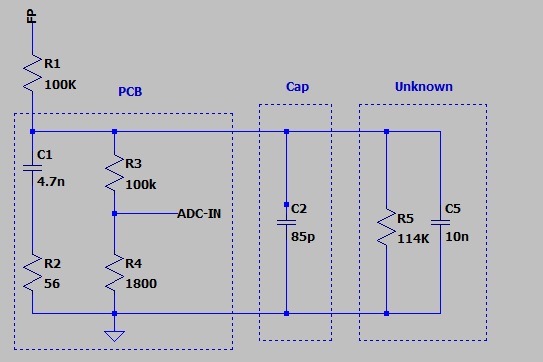I am searching for the cap load formula of C2 of the following circuit:

In the end I want to be able to determine the capacitance of C2 through the ADC-IN voltage.
The unknown part is a driver which sits besides the C2. The C5 is measured with and RLC meter after substracting the 4.7nF of C1. I applied 20VDC (30V/µs supply) and saw a voltage drop of 7V accross C2 - R5 is a pure assumption but seems to be accurate even with different FP voltages.
When i split the sections of the circuit, can I assume the following?:
I added R1 so the tau is in a measureable region.
C1 and R2 are a highpass filter which should send noise in the upper 100MHz against ground. - Can I ignore this part for the calculation?
R3 and R4 is a voltage divider for the ADC, this parallel to R5 is 53,85k Ohms.
I made the following assumpter:
At time = 0s and FP= 20V: Voltage is divided between R1 and (R3+R4)//R5 and the C1 and C5 start to load against 7V (resulting from the voltage divider).
I assume that R1 is my load resistor and I can ignore the R2-R5 for loading. So I have a capacitance of 10,085nF and after 1 tau (R1*(C2+C5)) I should be at 4,41V (63%)?
When I look at the graph measured parallel C2 i get 4nF:

Calculated with: Load time divided by R1 I tried with the load formula solved to get C. I get a slightly different result but still nearly 4nF. When I measure without C2 and then with and substract the result, I get the CAP (Result varies a bit, but I guess thats a user error)
What am I missing here?
Edit
I can remove C2 freely, so even if the CAPs have toleranz I have the possibility to remove C2 - make a measurement - and then add C2 and compare the two measurements.
